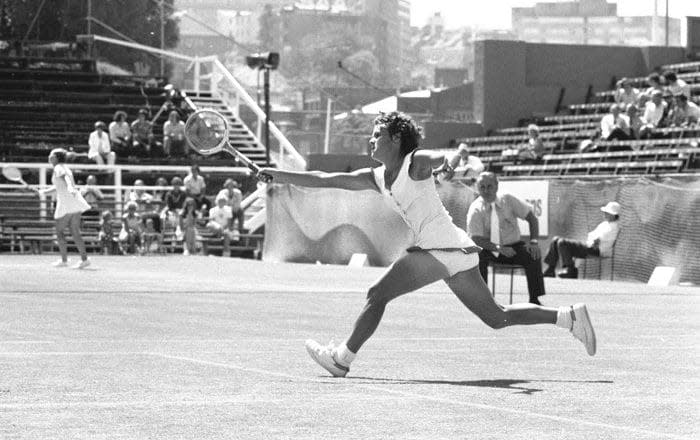Moment in Time: Evonne Goolagong wins 1974 Australian Open and inspires Ashleigh Barty

The 22-year-old Wiradjuri Aborigine from Barellan, a small cereal-belt town of vast wheatfields and grain silos 360 miles west of Sydney, may have already won the French Open and Wimbledon women’s singles in 1971 and already been honoured with an MBE and recognition as Australian of the Year while still in her teens, but a home slam – played on the grass courts at Kooyong – had been frustratingly elusive.
On each of the preceding three tournaments, she had lost in the final – forced to watch on as rivals Margaret Court, and Britain’s Virginia Wade, raised the Daphne Akhurst Memorial Cup. All the while, the wait for a first indigenous Australian victory in a global sporting event on home soil continued.
Goolagong, the third of eight children of Kenny and Melindra, the only “First Nations” family in her hometown, had loved hitting balls from an early age. Her father, a sheepshearer famous for being able to crop 100 a day, fashioned her a paddle from a wooden apple crate and she spent hours “rallying” with herself against walls and a water tank before she was drawn to the local tennis club to gape through the fence, trying to watch and learn.
She was invited in and swiftly, with the support of her neighbours, brought to the attention of the veteran Sydney coach Vic Edwards, who persuaded her parents to let her move to the city at the age of 10 to live with him and his family, and train to be a professional.
Goolagong, who had faced no prejudice in Barellan, encountered overt racist insults on the Sydney club circuit. At Edwards’s encouragement she blocked it out – an approach that lead to her accepting “honorary white” status to play at the South Africa Open in 1971, during Apartheid. It was a number of years before she felt able to embrace her heritage.
Throughout her playing career, media coverage lurched from stereotypical to disturbing. On the backpages in Australia, she was “Sunshine Super Girl”, in England “as warm and lovable as a puppy”. Then there was the creepier stuff. One British tabloid commissioned an artist to imagine what she looked like naked, and published his drawing to titillate lecherous readers, much to her distress on the eve of her 1972 Wimbledon campaign. Casual racism laced some news reports, The Sydney Morning Herald’s diarist hoped that “adulation will not turn her dusky head” and it became routine every time she could not press home an advantage to write that she “had gone walkabout”.

In that 1974 Australian Open final against American Chris Evert, Goolagong played in sweltering heat. The humidity was so intense the players were allowed to take a shower break before the deciding set and Goolagong returned with a wet handkerchief tied round her neck and a new tactical approach, to throw the ball higher on service, generating more power and precision and to approach the net more to stop Evert pinning her to the baseline.
It worked and she blew Evert away in the final set, “Goolagonged” as one paper put it, winning 6-0 and conceding only nine points. She won the title again in each of the next four years, missing out only in January 1977 when she was pregnant, but won it back the following tournament.
Her daughter Kelly, who was three when her mother regained the Wimbledon title in 1980, says her mum has come full circle in retirement, setting up the Evonne Goolagong Foundation to help indigenous young people.
“When I think about how much mum is loved by Australians from all walks of life and tennis fans around the world, ‘proud’ doesn’t even begin to cut it,” she said.
Ashleigh Barty, the world No 1 who became the second indigenous Australian woman to win Wimbledon, fittingly marked the 50th anniversary of Goolagong’s triumph in 2021 by wearing a dress modelled on the one she wore five decades ago in the final.
Barty, or “my little sister”, as her mentor and friend calls her, paid the warmest tribute. “I think she has been iconic in paving the way for young indigenous youth to believe in their dreams. Her legacy off the court is incredible.”
Barty winning in Melbourne, whenever that may be, will only add to it.

